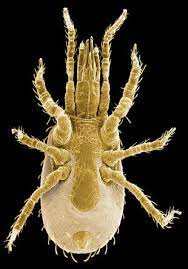Mesostigmata
Mesostigmata are a suborder of mites which are primarily characterized by their large stigmas, which preform numerous functions for the mites as both a function of the respiratory system and to capture and kill their prey. Mesostigmatic mites are the most prominent of all Acari, comprising up to 25% of the total mite population. Due to the large size of thier stigma and other mouthparts, they can often be mistaken for their relative the tick.

Taxonomy
| Domain | Kingdom | Phylum | Class | Order | |
|---|---|---|---|---|---|
| Classification | Eukaroyta | Animalia | Arthropoda | Arachnida | Mesostigmata |
Characteristics
Mesostigmatic mites begin their life cycle as larvae that appear similar to prostigmatic or astigmatic mites, with a rounded body covered in small setae. Setae are small hairs that line the body of mesostigmata that serve numerous purposes. Setae are very sensitive, helping the mites detect changes in their surroundings, differentiating between water and land environments, and possibly chemosensory actions such as distinguishing food types.[3] The setae also play a role in mating, releasing pheromones that can lure female mites. [3] During their life cycle, the mites molt several times while growing in size, shedding their prior exoskeleton when it becomes too small.

Impact on Soils
Mesostigmata are a very diverse subspecies, and have a great variety of feeding styles; including parasites, fungal feeders, and detritovores, which primarily feed on organic material. Over 11,632 species of mesostigmatic mites have been discovered, and it is estimated that at least 100,000 more species remain unclassified. [5] There are all types of these mites play a critical role in soil processes, but the soil dwelling mites tend to be parasitic. Mites that reside in soils are often smaller in size, and regular feed on nematodes and other mesofauna. Detritovoric mites impact soils by breaking down leaf litter, animal remains, and other organic matter that lies on the surface of soil beds in forests. Thus, the presence of mesostigmatic mites in a soil sample can indicate to scientists that the sample is healthy and contains a thriving ecosystem.[5] Despite these benefits, mesostigmatic mites are not as frequently soil dwelling as oribatid mites and prostigmatic mites.

References
[1] “Mesostigmata (Monogynaspida) Introduction.” Mesostigmata (Monogynaspida) - Introduction, https://idtools.org/id/mites/invasive_mite/Invasive_Mite_Identification/key/Mesostigmata/Media/Html/100Introduction.htm.
[2] Life Cycle of D. Gallinae and Checkpoints for the Evaluation of Vaccine ... Research Gate, https://www.researchgate.net/figure/Life-cycle-of-D-gallinae-and-checkpoints-for-the-evaluation-of-vaccine-efficacy-The-SEM_fig1_335920316.
[3] and [4] “Seta.” Seta - an Overview | ScienceDirect Topics, https://www.sciencedirect.com/topics/agricultural-and-biological-sciences/seta.
[5]“Mesostigmata.” Mesostigmata - an Overview | ScienceDirect Topics, https://www.sciencedirect.com/topics/agricultural-and-biological-sciences/mesostigmata.